Financial Management Report: University Financial Analysis, 2024
VerifiedAdded on 2022/12/18
|5
|774
|68
Report
AI Summary
This report delves into key aspects of financial management, providing a comprehensive analysis of various concepts. It begins by examining the tax implications of different financial agreements, emphasizing the differences between debt and equity financing, including the deductibility of interest on loans versus the tax treatment of equity. The report then explores the calculation of the cost of equity capital, explaining the role of the risk-free rate and market risk premium in determining the required returns for investors. Finally, it differentiates between the market value and book value of debt, outlining scenarios where each valuation method is applicable. The report uses academic references to support its points and provides a solid foundation for understanding financial management principles.
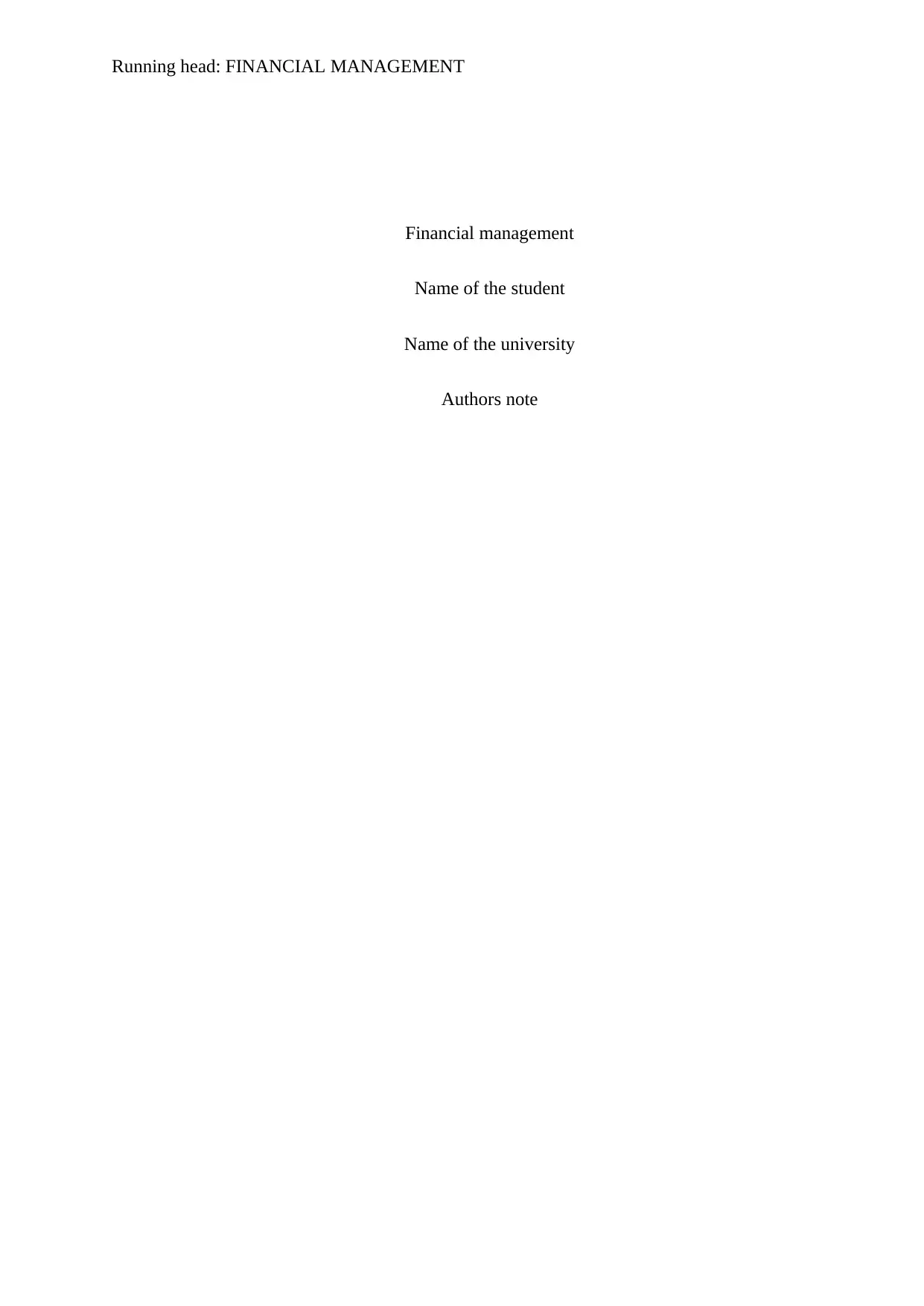
Running head: FINANCIAL MANAGEMENT
Financial management
Name of the student
Name of the university
Authors note
Financial management
Name of the student
Name of the university
Authors note
Paraphrase This Document
Need a fresh take? Get an instant paraphrase of this document with our AI Paraphraser
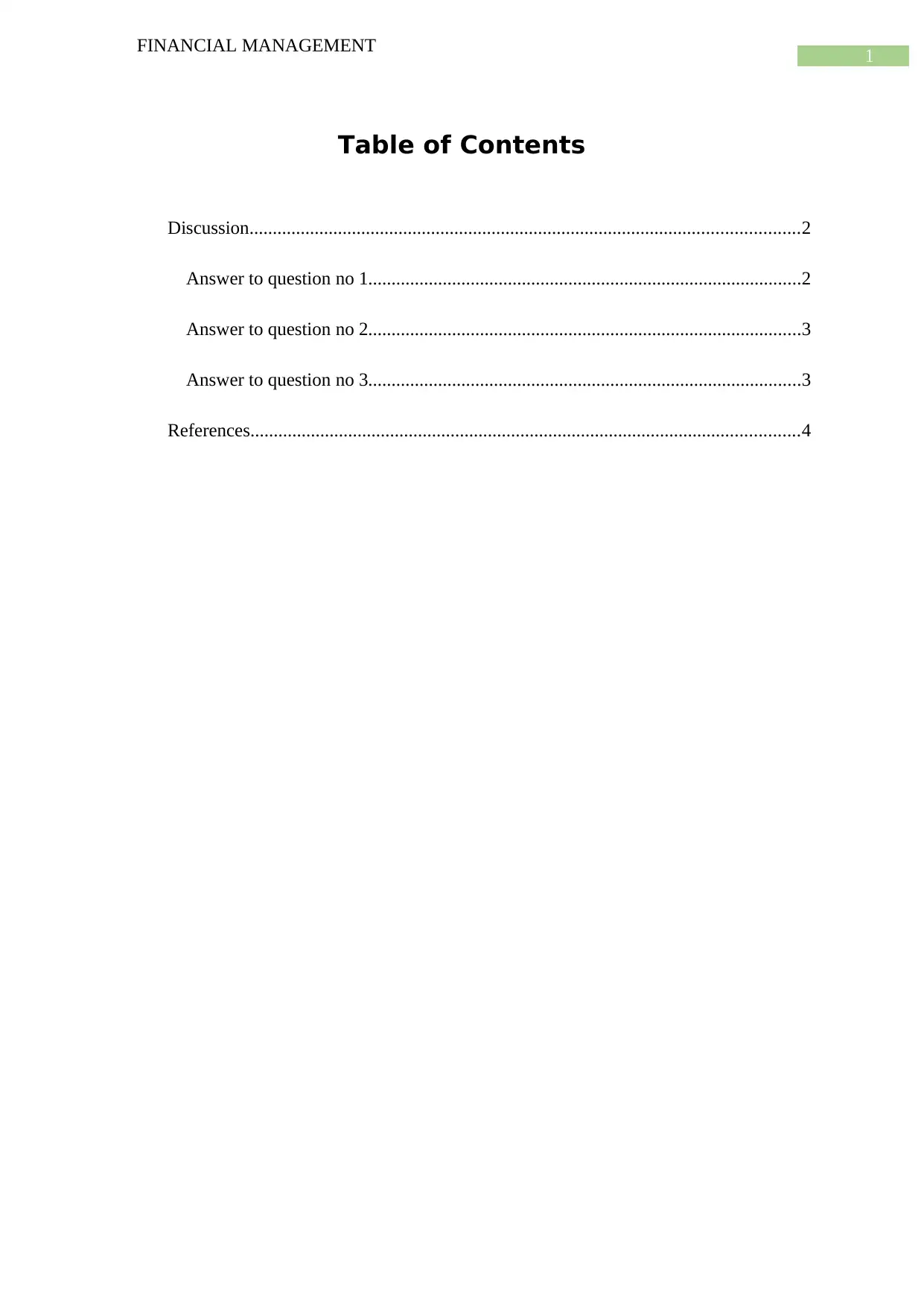
1
FINANCIAL MANAGEMENT
Table of Contents
Discussion......................................................................................................................2
Answer to question no 1.............................................................................................2
Answer to question no 2.............................................................................................3
Answer to question no 3.............................................................................................3
References......................................................................................................................4
FINANCIAL MANAGEMENT
Table of Contents
Discussion......................................................................................................................2
Answer to question no 1.............................................................................................2
Answer to question no 2.............................................................................................3
Answer to question no 3.............................................................................................3
References......................................................................................................................4
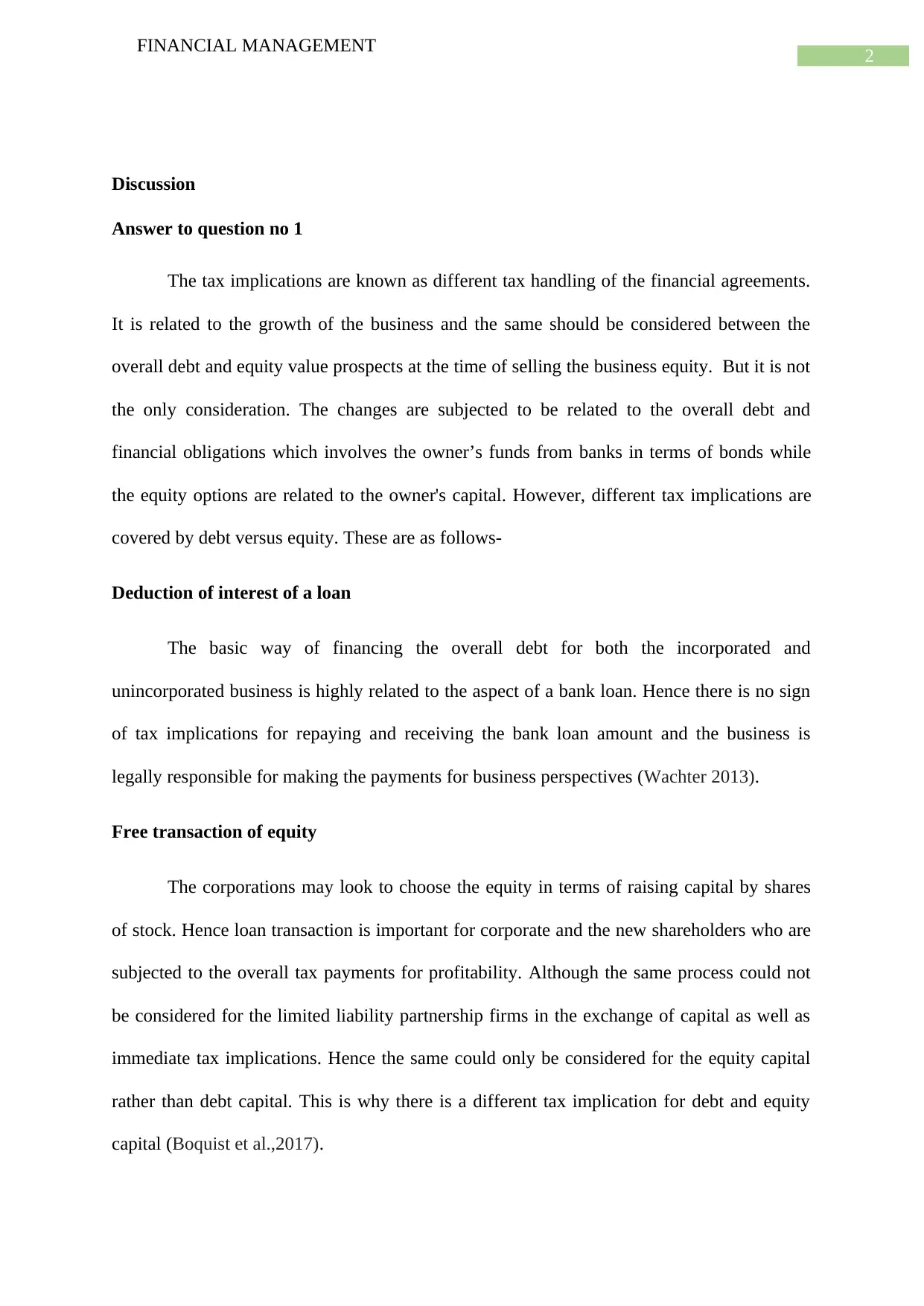
2
FINANCIAL MANAGEMENT
Discussion
Answer to question no 1
The tax implications are known as different tax handling of the financial agreements.
It is related to the growth of the business and the same should be considered between the
overall debt and equity value prospects at the time of selling the business equity. But it is not
the only consideration. The changes are subjected to be related to the overall debt and
financial obligations which involves the owner’s funds from banks in terms of bonds while
the equity options are related to the owner's capital. However, different tax implications are
covered by debt versus equity. These are as follows-
Deduction of interest of a loan
The basic way of financing the overall debt for both the incorporated and
unincorporated business is highly related to the aspect of a bank loan. Hence there is no sign
of tax implications for repaying and receiving the bank loan amount and the business is
legally responsible for making the payments for business perspectives (Wachter 2013).
Free transaction of equity
The corporations may look to choose the equity in terms of raising capital by shares
of stock. Hence loan transaction is important for corporate and the new shareholders who are
subjected to the overall tax payments for profitability. Although the same process could not
be considered for the limited liability partnership firms in the exchange of capital as well as
immediate tax implications. Hence the same could only be considered for the equity capital
rather than debt capital. This is why there is a different tax implication for debt and equity
capital (Boquist et al.,2017).
FINANCIAL MANAGEMENT
Discussion
Answer to question no 1
The tax implications are known as different tax handling of the financial agreements.
It is related to the growth of the business and the same should be considered between the
overall debt and equity value prospects at the time of selling the business equity. But it is not
the only consideration. The changes are subjected to be related to the overall debt and
financial obligations which involves the owner’s funds from banks in terms of bonds while
the equity options are related to the owner's capital. However, different tax implications are
covered by debt versus equity. These are as follows-
Deduction of interest of a loan
The basic way of financing the overall debt for both the incorporated and
unincorporated business is highly related to the aspect of a bank loan. Hence there is no sign
of tax implications for repaying and receiving the bank loan amount and the business is
legally responsible for making the payments for business perspectives (Wachter 2013).
Free transaction of equity
The corporations may look to choose the equity in terms of raising capital by shares
of stock. Hence loan transaction is important for corporate and the new shareholders who are
subjected to the overall tax payments for profitability. Although the same process could not
be considered for the limited liability partnership firms in the exchange of capital as well as
immediate tax implications. Hence the same could only be considered for the equity capital
rather than debt capital. This is why there is a different tax implication for debt and equity
capital (Boquist et al.,2017).
⊘ This is a preview!⊘
Do you want full access?
Subscribe today to unlock all pages.

Trusted by 1+ million students worldwide
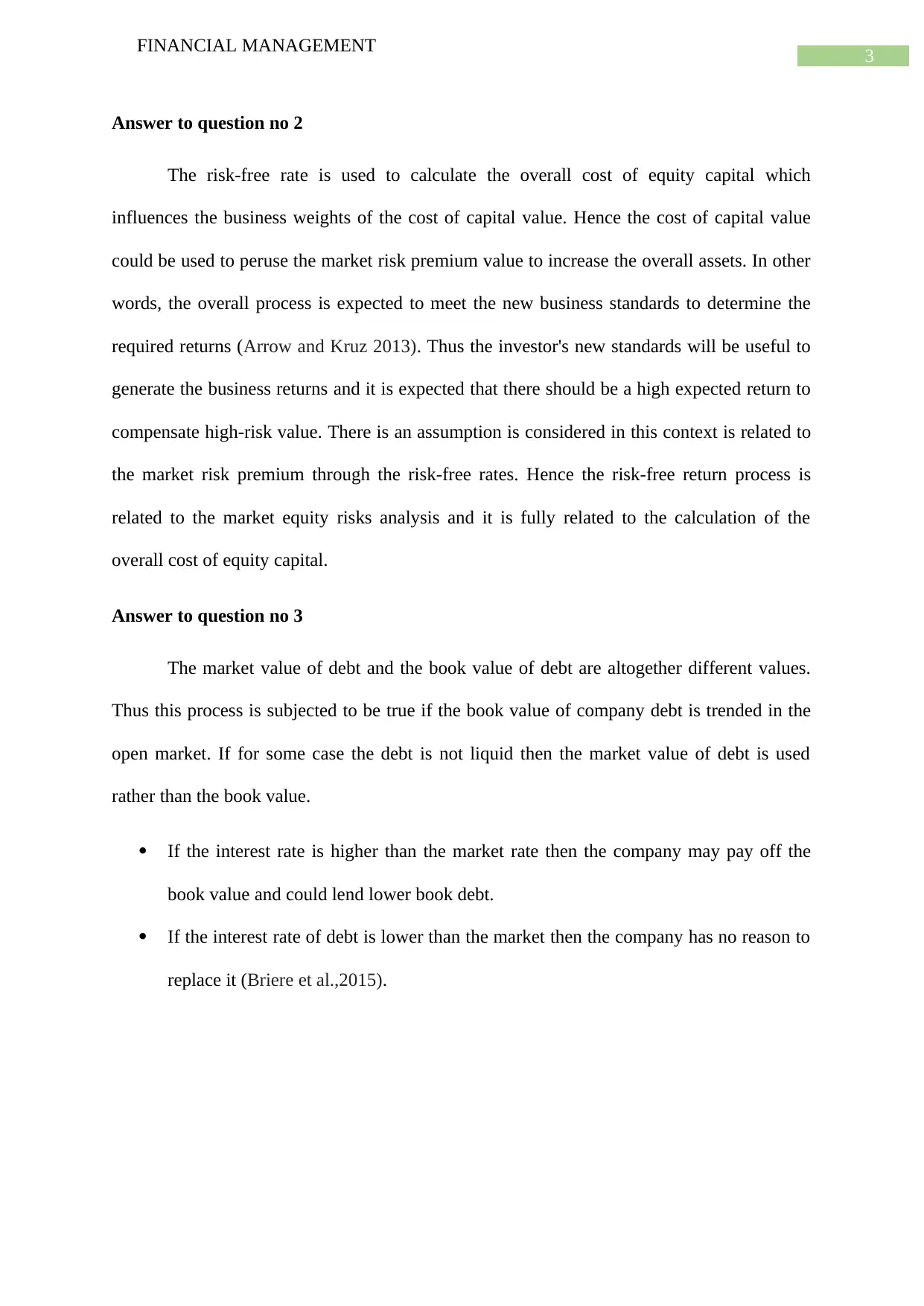
3
FINANCIAL MANAGEMENT
Answer to question no 2
The risk-free rate is used to calculate the overall cost of equity capital which
influences the business weights of the cost of capital value. Hence the cost of capital value
could be used to peruse the market risk premium value to increase the overall assets. In other
words, the overall process is expected to meet the new business standards to determine the
required returns (Arrow and Kruz 2013). Thus the investor's new standards will be useful to
generate the business returns and it is expected that there should be a high expected return to
compensate high-risk value. There is an assumption is considered in this context is related to
the market risk premium through the risk-free rates. Hence the risk-free return process is
related to the market equity risks analysis and it is fully related to the calculation of the
overall cost of equity capital.
Answer to question no 3
The market value of debt and the book value of debt are altogether different values.
Thus this process is subjected to be true if the book value of company debt is trended in the
open market. If for some case the debt is not liquid then the market value of debt is used
rather than the book value.
If the interest rate is higher than the market rate then the company may pay off the
book value and could lend lower book debt.
If the interest rate of debt is lower than the market then the company has no reason to
replace it (Briere et al.,2015).
FINANCIAL MANAGEMENT
Answer to question no 2
The risk-free rate is used to calculate the overall cost of equity capital which
influences the business weights of the cost of capital value. Hence the cost of capital value
could be used to peruse the market risk premium value to increase the overall assets. In other
words, the overall process is expected to meet the new business standards to determine the
required returns (Arrow and Kruz 2013). Thus the investor's new standards will be useful to
generate the business returns and it is expected that there should be a high expected return to
compensate high-risk value. There is an assumption is considered in this context is related to
the market risk premium through the risk-free rates. Hence the risk-free return process is
related to the market equity risks analysis and it is fully related to the calculation of the
overall cost of equity capital.
Answer to question no 3
The market value of debt and the book value of debt are altogether different values.
Thus this process is subjected to be true if the book value of company debt is trended in the
open market. If for some case the debt is not liquid then the market value of debt is used
rather than the book value.
If the interest rate is higher than the market rate then the company may pay off the
book value and could lend lower book debt.
If the interest rate of debt is lower than the market then the company has no reason to
replace it (Briere et al.,2015).
Paraphrase This Document
Need a fresh take? Get an instant paraphrase of this document with our AI Paraphraser
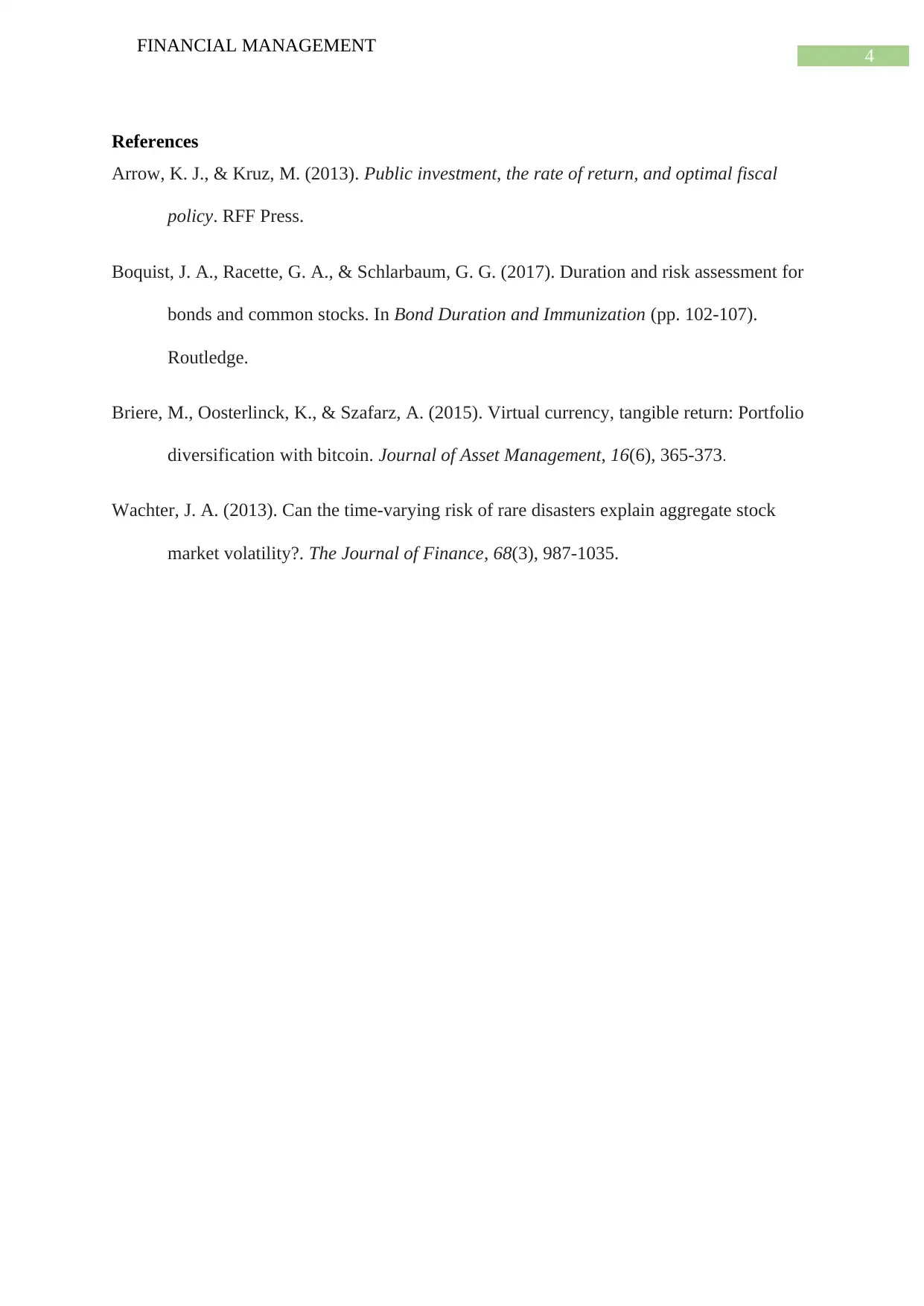
4
FINANCIAL MANAGEMENT
References
Arrow, K. J., & Kruz, M. (2013). Public investment, the rate of return, and optimal fiscal
policy. RFF Press.
Boquist, J. A., Racette, G. A., & Schlarbaum, G. G. (2017). Duration and risk assessment for
bonds and common stocks. In Bond Duration and Immunization (pp. 102-107).
Routledge.
Briere, M., Oosterlinck, K., & Szafarz, A. (2015). Virtual currency, tangible return: Portfolio
diversification with bitcoin. Journal of Asset Management, 16(6), 365-373.
Wachter, J. A. (2013). Can the time‐varying risk of rare disasters explain aggregate stock
market volatility?. The Journal of Finance, 68(3), 987-1035.
FINANCIAL MANAGEMENT
References
Arrow, K. J., & Kruz, M. (2013). Public investment, the rate of return, and optimal fiscal
policy. RFF Press.
Boquist, J. A., Racette, G. A., & Schlarbaum, G. G. (2017). Duration and risk assessment for
bonds and common stocks. In Bond Duration and Immunization (pp. 102-107).
Routledge.
Briere, M., Oosterlinck, K., & Szafarz, A. (2015). Virtual currency, tangible return: Portfolio
diversification with bitcoin. Journal of Asset Management, 16(6), 365-373.
Wachter, J. A. (2013). Can the time‐varying risk of rare disasters explain aggregate stock
market volatility?. The Journal of Finance, 68(3), 987-1035.
1 out of 5
Related Documents
Your All-in-One AI-Powered Toolkit for Academic Success.
+13062052269
info@desklib.com
Available 24*7 on WhatsApp / Email
![[object Object]](/_next/static/media/star-bottom.7253800d.svg)
Unlock your academic potential
Copyright © 2020–2025 A2Z Services. All Rights Reserved. Developed and managed by ZUCOL.





